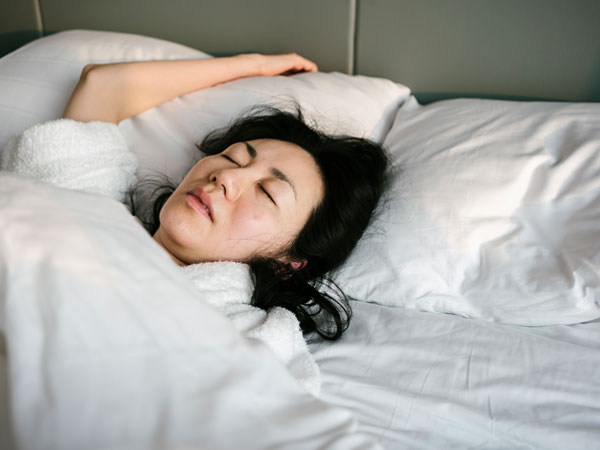- Home
- Science
- Diseases & Conditions
- Menopause
What Is Menopause?
Menopause is a natural life transition that occurs when people who are assigned female at birth do not have a menstrual period for 12 consecutive months.1 Menopause is a natural part of the aging process, occurring typically between the ages of 45 and 55.1 The average age of menopause in the United States is 51 years.2
Perimenopause is a period of time prior to menopause during which a person assigned female at birth may begin to experience changes in their periods, hot flashes, or other symptoms such as sleep disturbances, urinary urgency, and others. During perimenopause, the ovaries start to produce varying levels of the hormones estrogen and progesterone, which may give rise to these symptoms. But perimenopause affects bodies differently. Some people assigned female at birth may experience symptoms, but others may not.1
Perimenopause typically lasts about seven years, but it can be as long as 14 years. Race, ethnicity, age of onset of menopausal/hormonal changes, and smoking history can all influence the duration of perimenopause.1
Prevalence of Menopause
An estimated 1.3 million people assigned female at birth reach menopause annually in the U.S.2
About 10% of people assigned female at birth will reach menopause before age 45. If menopause occurs between ages 40-45, it is considered early. About 2% of people assigned female at birth experience menopause before age 40.3 Medical professionals call this premature menopause, and it may occur due to genetics or other causes of ovarian failure.2,3
A person’s ethnic or racial background also may affect menopause. For example:
- Black or Native American people assigned female at birth tend to have more hot flashes that are more intense, compared with other ethnicities.4
- People assigned female at birth who are Hispanic have a rate of hot flashes that is similar to those who are white but less than those who are Black.4
- Hispanic and Black people assigned female at birth experience more menopause-related sleep disruptions compared with those who are white.5
- Among people assigned female at birth, Black, Japanese, and Chinese people had poorer and shorter sleep related to menopause, compared with those who are white.5
- Black and Hispanic people assigned female at birth indicate that urinary incontinence worsens during and after menopause more than those who are white.6
Causes and Risk Factors
What Causes Menopause?

Menopause is a normal part of aging for people assigned female at birth, not a sickness or disorder.1 Menopause occurs when the ovaries no longer release eggs or produce the hormones progesterone and estrogen.7
In the time leading up to menopause, called perimenopause, declining levels of these hormones may lead to symptoms such as hot flashes, sleep disturbances, and others.1,8 Menstrual periods also may occur less regularly and then stop.8
Menopause can occur abruptly. For example, if a person assigned female at birth has their ovaries removed, the surgery will lead to menopause.7 Chemotherapy and hormone therapy for cancer may also lead to menopause.9
Menopause Onset
Research demonstrates that there are inequities associated with when people assigned female at birth experience menopause. These inequities may be driven by health factors, lifestyle, and socioeconomics.3,10 For example:
- Black, Hispanic, and Native Hawaiian people assigned female at birth tend to be younger than white people assigned female at birth when they enter menopause.3
- According to one study, the median age at which Black people assigned female at birth entered menopause was 8.5 months earlier than that of white people assigned female at birth.10
- Compared with non-Hispanic white people assigned female at birth, Japanese American people assigned female at birth tend to enter menopause at a later age.3
Regardless of one’s ethnic or racial background, other factors can affect the onset of menopause. Some include:
In addition to occurring naturally, menopause can occur following a surgery called bilateral oophorectomy, which includes the removal of both ovaries. Because the ovaries produce the sex hormones estrogen and progesterone, removing both leads to menopause. A person assigned female at birth may undergo a bilateral oophorectomy for cancer treatment or to reduce the risk of cancer returning.11,12
Chemotherapy and radiation can harm the ovaries and prevent periods and pregnancy, sometimes permanently.9,13 Hormone therapy for breast and uterine cancers can also lead to menopause.9
People who smoke may go through menopause up to two years earlier and experience more intense symptoms than nonsmokers.13
People with autoimmune diseases, HIV/AIDS, missing chromosomes, and chronic fatigue syndrome may undergo menopause earlier than expected.13
Menopause Stages
When people or healthcare providers talk about menopause, they may be talking about one of several stages related to menopause, each with specific criteria.
The first stage is perimenopause. Perimenopause is a time of transition prior to menopause when people assigned female at birth may experience changes to their periods and/or hot flashes. On average, perimenopause lasts approximately seven years.1,14 It starts when menstruation becomes irregular and stops when a person undergoes menopause, which is a year after the last menstrual period.14,15 Perimenopause is also divided further into two stages:15
- Early transition: Menstrual cycles are still somewhat consistent
- Late transition: When the time without a period extends past 60 days
The second stage is menopause. Menopause occurs on the day when a person assigned female at birth has gone 12 months since their last period.1 After this point, pregnancy is not possible.8
This is the time after menopause.16 A person assigned female at birth is considered postmenopausal if they have gone more than 12 months without a period.1
Menopause Symptoms

Menopause symptoms may vary among people assigned female at birth, and they may last for five or more years. Additionally, surgical menopause symptoms can be intense and have a sudden onset.8
People assigned female at birth first may notice changes in their periods, which may occur more or less often. For example, they may get a period every three weeks and then start to miss periods. In other cases, people assigned female at birth may experience irregular periods for one to three years before periods cease.8
Other menopause symptoms can include:
- Hot flashes,1 which may be more intense in the first one to two years8
- Night sweats,8 which are hot flashes that occur at night17
- Sleep difficulties, which can include trouble falling asleep, trouble staying asleep, or waking earlier than planned1
- Depression or anxiety1,8
- Painful intercourse1
- Irritability, moodiness, and mood swings1,18
- Racing or pounding heart8
- Heart palpitations8
- Flushing of the skin8
- Decreased libido8
- Vaginal dryness/itchiness8
- Vaginal infections8
- Forgetfulness or brain fog or difficulty concentrating8,19
- Pain and aches in the joints8
- Headache8
- Leakage of urine or a sudden need to urinate1,8
- Weight gain1
Menopause Complications

Menopause complications can stem from dips in the level of the hormone estrogen. One of the leading menopause complications is osteoporosis, a condition that affects the density and strength of bone.2
Declining estrogen levels during menopause can lead to lower bone density. It’s estimated that osteoporosis affects more than 250,000 people assigned female at birth who are menopausal or postmenopausal. At the age of 40, women begin to lose bone at a rate of 0.3% to 0.5% per year. The rate of bone loss increases in menopause to 3% to 5% per year for the first five to seven years.2
Cardiovascular disease (CVD) is another common menopause complication. Declining estrogen levels can lead to vasoconstriction (narrowing of blood vessels) and changes to cholesterol.2,20 This elevates CVD risk, including coronary artery disease and stroke.2,3 The risk of coronary heart disease is two to three times higher after reaching menopause than it is for people assigned female at birth who have not reached menopause at the same age. Diet and exercise may lower CVD risk.2
Diagnosis and Treatment
Menopause Diagnosis
Formally, menopause is the day on which a person assigned female at birth has gone 12 consecutive months without a period.1 Typically, the emergence of symptoms and signs notify a person assigned female at birth that they’re approaching menopause. Healthcare providers do not typically diagnose it.2,21
When a person assigned female at birth talks to a healthcare provider about their symptoms, the healthcare provider typically identifies the symptoms, rules out other conditions for people over the age of 45, and factors in the patient’s age.2 Two of the more common symptoms that a healthcare provider will look for are changes to the patient’s periods and the presence of hot flashes.2,8 Other common symptoms may include night sweats,8 which are hot flashes that occur at night,17 trouble sleeping,1 and irritability, moodiness, and mood swings.1,18
In addition to looking for these and other symptoms, healthcare providers can also perform urine or blood tests to evaluate hormone levels, which may indicate perimenopause or postmenopause.21,8
Menopause Symptom Management
Healthcare providers tend to focus on managing menopause symptoms that affect quality of life and strive to help patients avoid long-term complications.2 Hormonal treatments may help achieve both objectives.2
Certain hormonal treatments have been approved by the U.S. Food and Drug Administration (FDA) to treat moderate to severe hot flashes due to menopause.2,22 Additionally, the FDA has approved hormonal treatments to address vaginal changes due to menopause, including painful sex.22 And finally, the FDA has approved hormonal treatments to prevent postmenopausal osteoporosis.22 Hormone therapy comes with risks, which should be weighed with a healthcare provider.2
Healthcare providers may also prescribe selective estrogen receptor modulators (SERMs), but not all SERMs work the same way or have the same effects. One SERM may help prevent or treat postmenopausal osteoporosis. Another SERM is combined with estrogens into one medication to treat moderate to severe hot flashes and prevent postmenopausal osteoporosis.2,23 Another SERM can treat moderate to severe painful sex due to menopause.22
Additionally, healthcare providers may turn to non-hormonal treatments to help with menopause. The FDA has approved one selective serotonin reuptake inhibitor (SSRI) to treat hot flashes.2 SSRIs increase serotonin, a neurotransmitter.24 And in May 2023, the FDA approved a neurokinin 3 receptor agonist to help with moderate to severe hot flashes.25 This type of medication targets a specific neural pathway that has been linked to hot flashes.26
To help manage osteoporosis, healthcare providers may also recommend calcium and vitamin D supplementation, along with other vitamins and minerals critical for bone health, such as vitamin K2 and magnesium.27 Physical activity and quitting smoking may also lessen osteoporosis risk.2
According to the National Library of Medicine, certain lifestyle changes may also help with menopause management. Identifying symptom triggers such as spicy foods, caffeine, or alcohol may be helpful. Additionally, physical exercise, intentional breathing exercises during hot flashes, and Kegel exercises may help. Other ways to help manage symptoms may include acupuncture, dressing in layers to deal with hot flashes, remaining sexually active, and using lubricants and vaginal moisturizer during sex.8
Global Impact of Menopause

Researchers estimate that by 2050 there will be 1.6 billion people assigned female at birth who have reached menopause worldwide. In 2020, there were a billion people worldwide who had reached menopause. Up to 75% of people in menopause experience hot flashes, night sweats, and other symptoms.28
Despite the common nature of menopause, many people assigned female at birth do not discuss it with a healthcare provider. Research in the U.K. indicated that 45% of people assigned female at birth had not talked to a healthcare provider about their menopause symptoms.29
This has implications for how people assigned female at birth live and work. In 2020, an estimated 657 million people assigned female at birth were between the ages of 45 and 59 across the globe, and about half of these were in the workforce.30 Research in the U.K. indicated that one out of 10 people assigned female at birth have left the U.K. workforce due to menopause.29 In a 2022 survey of 1,045 people assigned female at birth aged 40 to 64 in the U.S., who all reported experiencing at least one instance of hot flashes or night sweats in the past month, 12% said menopause affected their performance at work.31
Education surrounding menopause is also lacking. Around the world, many communities, families, workplaces, and even healthcare settings may not discuss menopause. People assigned female at birth may not know their symptoms are due to menopause, or what treatment options they have. Healthcare providers may not be adequately trained in how to help. Menopausal symptoms such as vaginal dryness and painful intercourse go unaddressed because sexual wellbeing is overlooked. Moreover, many menopause health services receive inadequate funding.32
Frequently Asked Questions About Menopause
- How long does menopause last?
Perimenopause—when many people assigned female at birth may begin to experience menopause symptoms—lasts about seven years but can be up to 14 years. Menopause occurs on the day that it has been 12 consecutive months since a person assigned female at birth has had a period.1 A person assigned female at birth is considered to be in postmenopause once they have gone more than 12 months without a period.8
- What is menopause?
Menopause marks the point 12 months after a person assigned female at birth experienced their final period. It is a natural part of aging and not a disease or disorder.1
Menopause is preceded by perimenopause, a time of transition when a person assigned female at birth may begin to experience changes to their periods or hot flashes. During this period of time, the ovaries produce varying levels of the hormones estrogen and progesterone.1
Menopause is followed by postmenopause. At this stage, people assigned female at birth can no longer get pregnant,8 and they are at risk of heart disease and osteoporosis.1
- When does menopause start?
Menopause occurs typically somewhere between the ages of 45 and 55. Menopause takes place at the average age of 51 years.1,2
Early menopause is menopause that occurs between the ages of 40 and 45.2 Among people assigned female at birth, approximately 10% will experience menopause prior to turning 45.3 Approximately 2% of people assigned female at birth will experience menopause prior to turning 40.3 This is considered “premature menopause” by medical professionals, and it may have genetic origins or stem from other types of ovarian failure.2,3
- Do men go through menopause?
Menopause only affects people who are assigned female at birth.1 These people officially reach menopause after 12 months have gone by without having a period.1
- Can you get pregnant after menopause?
Menopause happens on the day that it has been 12 months after a person assigned female at birth has had a period.1 After this point, pregnancy is not possible.8 During perimenopause, it is still possible to become pregnant.32
Learn More About Menopause
Find a Pfizer clinical trial for menopause at PfizerClinicalTrials.com.
Explore menopause clinical trials at ClinicalTrials.gov.
Area of Focus: Internal Medicine
Menopause is a focus of Pfizer’s Internal Medicine Therapeutic Area. Visit the Internal Medicine Page.
- References
- What is menopause? National Institute on Aging. https://www.nia.nih.gov/health/what-menopause. Updated September 30, 2021. Accessed May 10, 2023.
- Peacock K, Ketvertis K. Menopause. StatPearls. https://www.ncbi.nlm.nih.gov/books/NBK507826/. Updated August 11, 2022. Accessed May 10, 2023.
- El Khoudary SR, Aggarwal B, Beckie TM, et al. Menopause Transition and Cardiovascular Disease Risk: Implications for Timing of Early Prevention: A Scientific Statement From the American Heart Association. Circulation. 2020;142(25):e506-e532. doi:10.1161/CIR.0000000000000912
- Swan hot flash fact sheet. SwanStudy.org. https://www.swanstudy.org/wps/wp-content/uploads/2023/04/SWAN-Fact-Sheets-Hot-Flashes.pdf. Accessed May 10, 2023.
- Sleep during the menopausal transition. SwanStudy.org. https://www.swanstudy.org/wps/wp-content/uploads/2023/04/SWAN-Fact-Sheets-Sleep.pdf. Accessed May 10, 2023.
- Urinary incontinence (UI). SwanStudy.org. https://www.swanstudy.org/wps/wp-content/uploads/2023/04/SWAN-Fact-Sheets-VUSH.pdf. Accessed May 10, 2023.
- What causes menopause? Eunice Kennedy Shriver National Institute of Child Health and Human Development. https://www.nichd.nih.gov/health/topics/menopause/conditioninfo/causes. Updated November 16, 2021. Accessed May 10, 2023.
- Menopause. MedlinePlus. https://medlineplus.gov/ency/article/000894.htm. Updated July 13, 2021. Accessed May 10, 2023.
- Cancer treatment – early menopause. MedlinePlus. https://medlineplus.gov/ency/patientinstructions/000912.htm. Updated October 25, 2022. Accessed July 4, 2023.
- Harlow SD, Burnett-Bowie SAM, Greendale GA, et al. Disparities in reproductive aging and midlife health between Black and White women: The study of women’s health across the nation (SWAN). Womens Midlife Health. 2022;8(1):3.
- Secoșan C, Balint O, Pirtea L, Grigoraș D, Bălulescu L, Ilina R. Surgically induced menopause—a practical review of literature. Medicina. 2019;55(8):482.
- Lawson A; Rentea R. Oophorectomy. StatPearls. https://www.ncbi.nlm.nih.gov/books/NBK559235/. Updated May 8, 2022. Accessed May 10, 2023.
- Early or premature menopause. Office on Women’s Health. https://www.womenshealth.gov/menopause/early-or-premature-menopause. Updated December 29, 2022. Accessed August 15, 2023.
- Delamater L, Santoro N. Management of the perimenopause. Clinical Obstetrics and Gynecology. 2018;61(3):1.
- Santoro N. Perimenopause: From research to practice. Journal of Women’s Health. 2016;25(4):332-339.
- Postmenopausal. National Cancer Institute. https://www.cancer.gov/publications/dictionaries/cancer-terms/def/postmenopausal. Accessed May 10, 2023.
- Hot flashes: What can I do? National Institute on Aging. https://www.nia.nih.gov/health/hot-flashes-what-can-i-do. Updated September 30, 2021. Accessed July 4, 2023.
- Menopause. Endocrine Society. https://www.endocrine.org/patient-engagement/endocrine-library/menopause. Updated January 24, 2022. Accessed July 4, 2023.
- Maki PM, Jaff NG. Brain fog in menopause: A health-care professional’s guide for decision-making and counseling on cognition. Climacteric. 2022;25(6):570-578.
- Vasoconstriction. MedlinePlus. https://medlineplus.gov/ency/article/002338.htm. Accessed May 10, 2023.
- How do healthcare providers diagnose menopause? Eunice Kennedy Shriver National Institute of Child Health and Human Development. https://www.nichd.nih.gov/health/topics/menopause/conditioninfo/diagnosed. Update November 16, 2021. Accessed May 10, 2023.
- The 2022 hormone therapy position statement of The North American Menopause Society. Menopause. 2022;29(7):767-794.
- Lello S, Capozzi A, Scambia G. Is there still a role for SERMs in menopause management? Gynecological Endocrinology. 2020;36(7):567-568.
- Chu A, Wadhwa R. Selective serotonin reuptake inhibitors. StatPearls. https://www.ncbi.nlm.nih.gov/books/NBK554406/. Updated May 1, 2023. Accessed July 5, 2023.
- FDA approves novel drug to treat moderate to severe hot flashes caused by menopause. U.S. Food & Drug Administration. https://www.fda.gov/news-events/press-announcements/fda-approves-novel-drug-treat-moderate-severe-hot-flashes-caused-menopause. May 12, 2023.
- Anderson RA, Cormier J, Thieroff-Ekerdt R, et al. Pharmacodynamic activity of the novel neurokinin-3 receptor antagonist sjx-653 in healthy men. The Journal of Clinical Endocrinology & Metabolism. 2020;105(12):e4857-e4865.
- Rodríguez-Olleros Rodríguez C, Díaz Curiel M. Vitamin k and bone health: a review on the effects of vitamin k deficiency and supplementation and the effect of non-vitamin k antagonist oral anticoagulants on different bone parameters. Journal of Osteoporosis. 2019;2019:1-8.
- Zhang GQ, Chen JL, Luo Y, et al. Menopausal hormone therapy and women’s health: An umbrella review. Myers JE, ed. PLoS Med. 2021;18(8):e1003731.
- The Lancet. Attitudes towards menopause: Time for change. The Lancet. 2022;399(10343):2243.
- Rees M, Bitzer J, Cano A, et al. Global consensus recommendations on menopause in the workplace: A European Menopause and Andropause Society (EMAS) position statement. Maturitas. 2021;151:55-62.
- Richard-Davis G, Singer A, King DD, Mattle L. Understanding Attitudes, Beliefs, and Behaviors Surrounding Menopause Transition: Results from Three Surveys. Patient Relat Outcome Meas. 2022;13:273-286. Published 2022 Dec 14. doi:10.2147/PROM.S3751440.
- Menopause. World Health Organization. https://www.who.int/news-room/fact-sheets/detail/menopause. Updated October 17, 2022. Accessed May 10, 2023.
The information contained on this page is provided for your general information only. It is not intended as a substitute for seeking medical advice from a healthcare provider. Pfizer is not in the business of providing medical advice and does not engage in the practice of medicine. Pfizer under no circumstances recommends particular treatments for specific individuals and in all cases recommends consulting a physician or healthcare center before pursuing any course of treatment.

